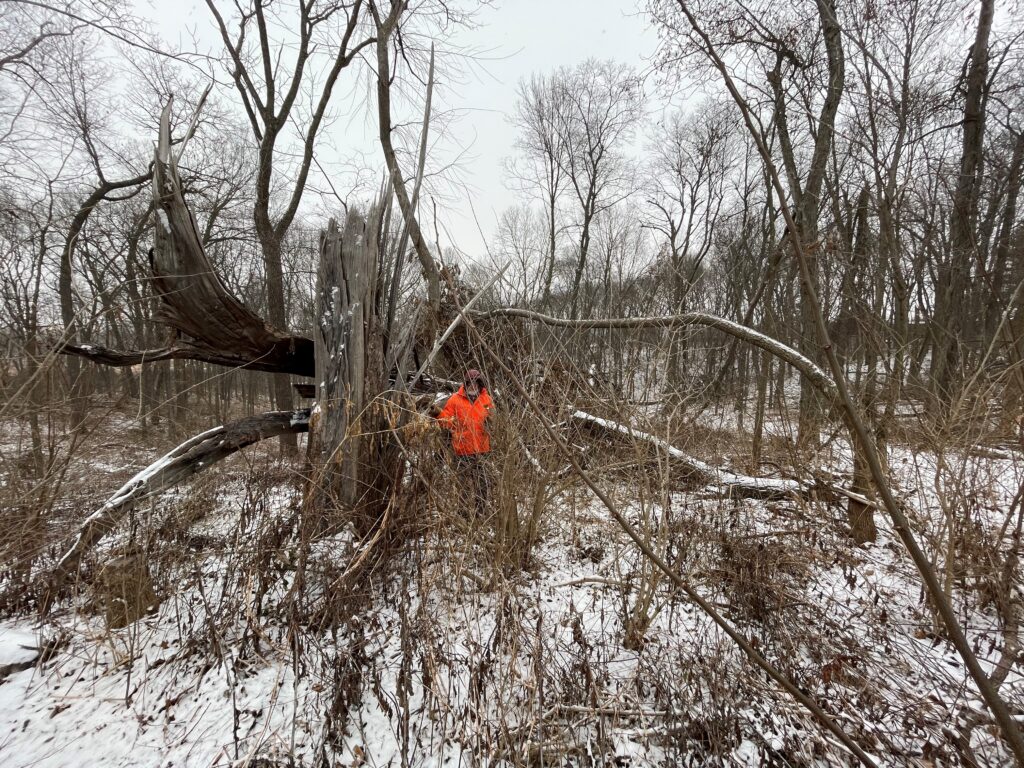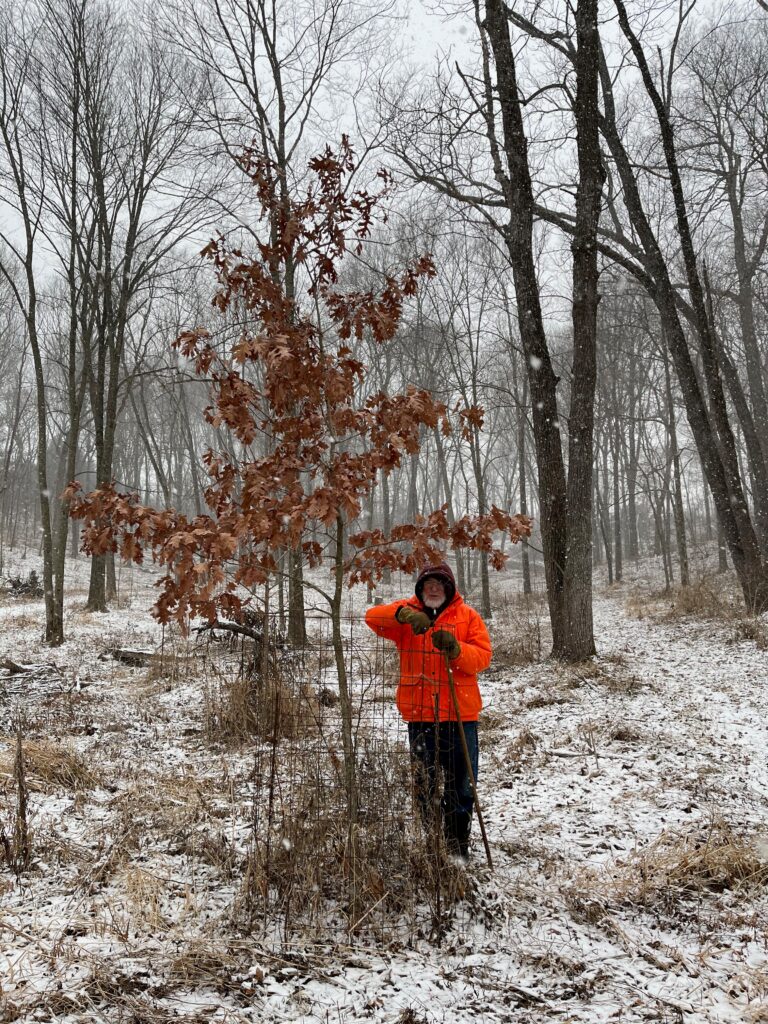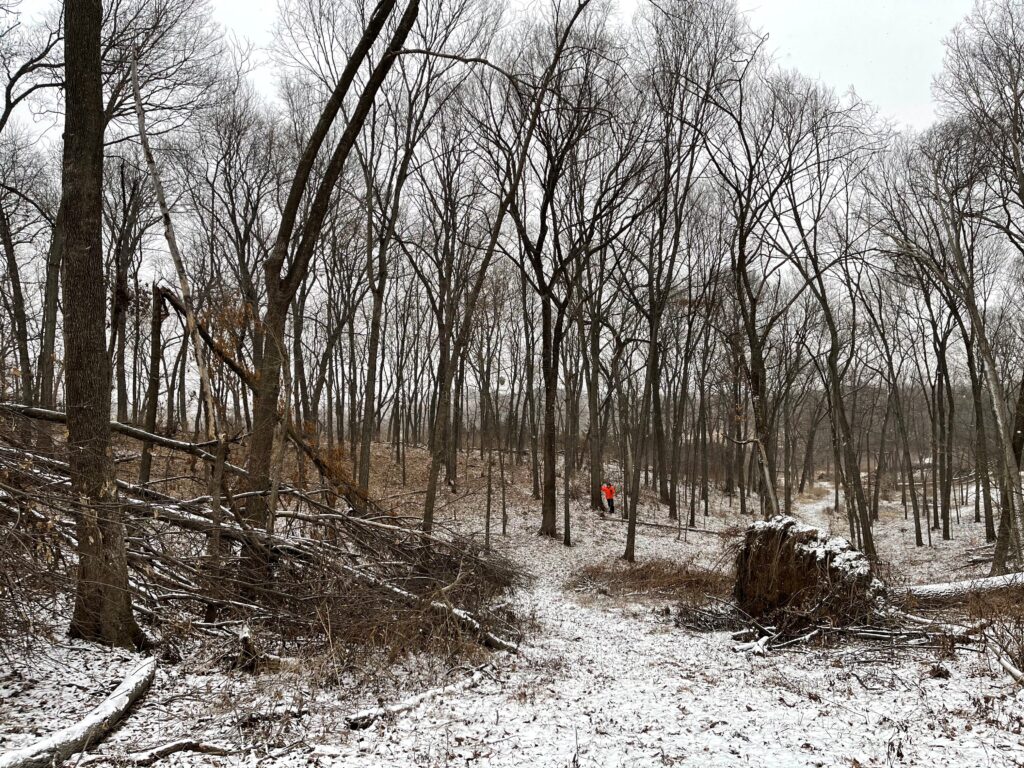Managing a Firewood Woodlot
Heating your house with firewood is sometimes rated as carbon neutral because it is solar energy via photosynthesis, stored as cellulose and lignin. And if the amount of carbon dioxide released by burning the wood is sequestered again by other trees growing where your wood came from, then there is opportunity to come close to creating a cycle with little long-term net impact on the atmospheric carbon dioxide balance. How close you actually come to break-even also depends upon how much energy from other sources you expend to utilize the wood.
The ideal is to live in the woods or on the edge of a woodlot, so that very little petroleum fuel is used by chainsaw, log-splitter, tractor and truck to go from a whole tree to a stack of firewood on your doorstep. Our house is a stone’s throw from a seven-acre wood, and we have heated it with firewood for the past 43 years. When teaching an energy class at the University of Iowa, we have used our place as a field trip example of that mode, and calculated that the ratio of our energy production, from burning the wood to the gasoline energy used to produce it, is about 80:1, far better than most other energy sources.

Results of last summer’s storms. The shattered vertical trunk is a walnut, originally weakened by a lightening strike a decade before, and the bent and tangled ones are mostly hackberry. Photos courtesy of Kate Sulentic.
Wood quality plays some role in efficiency. Species which are dense after drying – oak, hickory, locust or red elm – provide the most BTUs for the energy you put into the firewood process. When we built on the edge of our seven-acre community woodlot in the 1970s, it was dominated by elm just in time for Dutch elm disease to sweep through and kill most of them. So for about a decade, we burned mostly red elm, hard and dense, with the additional advantage of shedding its bark while still standing, producing a very clean firewood with no bark and no bugs. It is so hard that the woodpeckers do not drill their nest cavities into it, so it has less habitat value than the white elm, which keeps its bark while standing, becomes soft and drillable. These characteristics make the white elm home to woodpeckers, flickers, and those that use the abandoned cavities in subsequent years, such as our white-breasted nuthatch, black-capped chickadee, screech owl, bats, and on sunny edges, the bluebird.
Hackberry was common in the woods at that time and replaced the elm after the woods went through a decade of growing many patches of weeds and brush in the light gaps of the canopy. Box elder also moved into the light gaps, but today, about 40 years later, their sprawly growth has been shaded out by the mostly closed canopy and they have mostly died. They make acceptable firewood, but I leave them standing dead because they are often hollow and the woodpeckers drill them for cavities. So hackberry now takes much of the abuse of the summer storms, lightening strikes, drought and other forces that work to aid prairie replacing forest.
Oak needs direct sunshine throughout its career, and is vulnerable to deer grazing, so about the only place it thrives naturally is around the edges of the woodlot. I tried planting some seedlings in the larger light gaps in the canopy and they didn’t make it unless I also provided a deer cage around them. The hickories are somewhat more shade tolerant than the oaks, and some attain trunks about a foot in diameter. But eventually, most of them get outcompeted by the hackberry and other species and die off. So today, hackberry is our dominant species, perhaps 50-60 percent of all the trees, especially more toward the center of the woods away from the sunny edges. It is OK firewood, and some years we burn mostly dead and damaged hackberry. It is also useful to wildlife, both the little berries which birds and squirrels favor, and the leaves which feed an assortment of moth and butterfly caterpillar species that in turn feed the birds and mice.
Here on the edge of the prairie, small recovering woodlots like ours are not particularly stable and are vulnerable to rapid change. Intense windstorms tear through, especially in recent years, and cut swaths of fallen and broken trees. This creates light gaps in the canopy for the tree cycle to begin anew. My firewood harvest in some years is limited to keeping the two trails open and turning the wreckage into firewood. The soils reveal that the woodlot was originally part of an oak-hickory type of woodland. In our recent era, it seems to be forever young with not enough stability to grow any really large trees. Large woodlands seem to do better with the many trees helping to shelter one another and some get granted the option to become old growth. See my blog, “The Advantages of Contiguous Conservation Properties,” for more on this aspect.
In our forever young woods, above, note how all the trees are slender. More intensive management, mainly selective thinning, would provide more sunlight to those remaining trees and could help shift the species mix away from hackberry dominance. But I don’t have that amount of ambition and don’t need any more firewood. So while our woodlot provides oxygen, wildflowers, wildlife, firewood, recreation, a place for children to learn about nature, and is a sink for carbon dioxide, its present management is not leading toward old growth a century from now.




